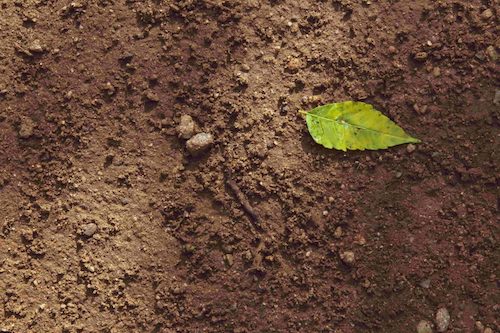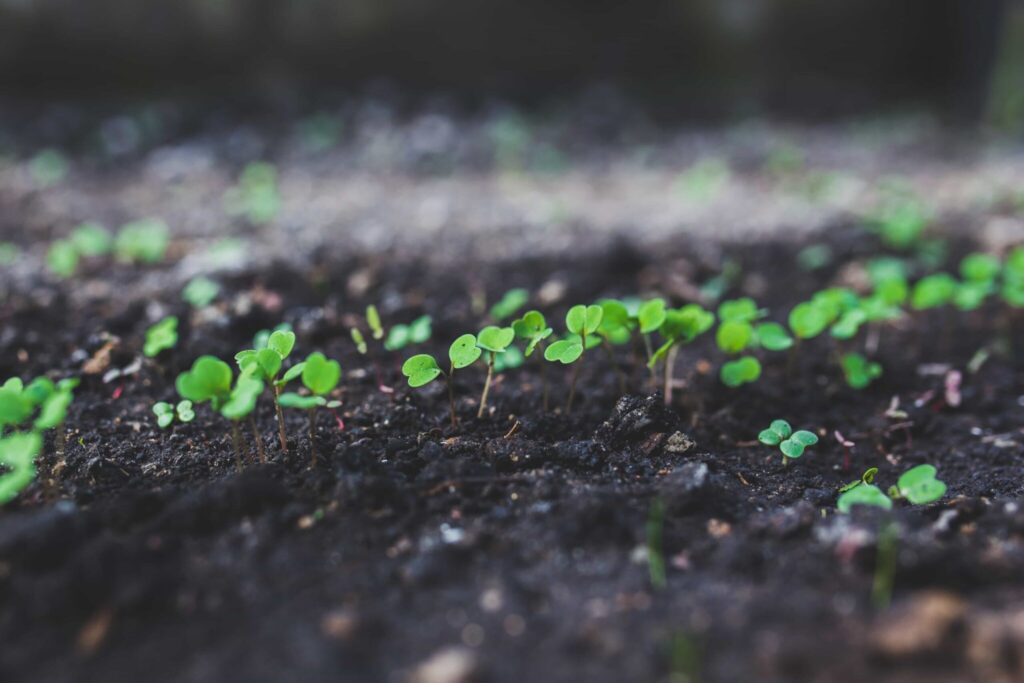Log in or create new account to save this product to your wishlist.

How to Improve Soil Quality: Analysing Your Garden Soil Type
The soil condition affects the health of your lawn, hedges, flowerbeds, and roses! Find out how to determine your garden's soil conditions and which improvements to make!
🌱 All important maintenance moments for your lawn during the year. Leave your email and we will send you the lawn calendar for free.
Enter your email
Receive the lawn calendar in the mail
Enjoy a green lawn all year round!

- Order by 2PM = shipped today
- 250.000+ satisfied customers!
- 60 day satisfaction guarantee
Light, medium, or heavy — the classification of your garden soil is reminiscent of Olympic martial arts! But in this case, the soil type says more about which plants will feel at home in your garden than the strength of the soil’s structure. Read on to find out how to improve soil quality – it’s simple!!!
- How to determine your garden soil quality
- How to improve soil quality
In this article, we’ll explore how to improve soil quality in your garden and how to ensure your garden grows beautifully all year round.
Ready? Let’s get to it.
How to determine your garden soil quality

Finding out what type of earth you have in your garden is a simple case of getting your hands a little dirty.
Take a handful of damp garden soil and shape it into a ball. Then, roll it into a sausage. You have sandy soil if the ball crumbles and loses shape when you roll it. But you have medium-clay soil if the sausage holds its shape while maintaining a smooth surface. But if the sausage is sticky to the touch, you have heavy clay soil.
So, which is best? Light, mid, or heavy soil?
Garden soil quality – Light, sandy
Light soil is light brown in colour and sandy, loose, and crumbly in texture — often referred to as sandy soil.
Sandy soil drains very well – suitable for plants that don’t like to sit in soggy earth, such as hardy geraniums, tulips, and lavender.
However, this also means that sandy soil loses its moisture quickly — so you’ll probably be continuously watering your plants and lawn.
Sandy soil can be problematic for lawns, which need at least 1 inch of water weekly. In this case, you can improve the soil quality by adding improvers — read on for more details.
Plants that enjoy sandy soil
- Lupins
- Iris
- Cornflower
- Ball thistle
- Lilac
- Sea buckthorn berry
- Hornbeam
Garden soil quality – Medium-heavy
If you have medium-heavy soil, you’re in luck because it’s the best of both worlds — holding onto moisture AND draining well. Medium-heavy soils, therefore, don’t flood as quickly as heavy soils, and you don’t need to water your lawn or plants as regularly.
Because medium-heavy earth has good and relatively consistent water content, it warms up quickly in the spring, providing optimal growing conditions for numerous plants, such as chard, roses, and grass.
If you have medium-heavy soil, put your feet up — you don’t need to improve your growing conditions. But don’t forget that all soils still benefit from regular fertilisation.
Plants that thrive in medium-heavy soil
Flowering shrubs, such as:
- Weigela
- Hydrangea
- Buddleja
- Forsythia
Garden soil quality – Heavy soil

Heavy clay soils retain lots of water, which is good unless it gets saturated. You’ll find rich clay earth becomes easily waterlogged and lacks drainage, which can rot plant roots.
And as if that wasn’t bad enough, heavy, dense soil is low in oxygen because the surface air can’t penetrate the soil. So, while the clay is high in nutrients, the lack of oxygen can stunt plant growth.
This makes heavy soil particularly inhospitable for many plants — although you’ll find a proliferation of weeds because they love it!
Heavy soil warms up very slowly, so you may notice slow growth at the beginning of spring. But don’t worry; it’ll catch up as the ambient temperature increases.
Heavy soil-loving plants

While heavy soil is a challenge for many plants, some plants thrive in highly nutritious, dense earth, including:
- Roses
- Foxglove
- Hydrangea macrophylia
- Primrose
- Aster
- Day lily
- Forsythia
- Elder
- Thalictrum
How to improve soil quality
If you have heavy or light soil, you could improve the soil conditions to neutralise their extremes. Medium-clay soil: nothing to worry about!
Light soil
Firm up light soil by adding nutritious compounds that hold its structure, such as homemade compost, clay mineral flour, mulch, leaf mould, or horticultural clay. This will bring better water-retentive properties to your soil, helping it maintain its natural nutrients.
If you have light sandy lawn soil, add topsoil for extra structure and fertilise well because the nutrients are easily washed away with sandy soils.
Heavy soil
You can improve heavy soil by mixing it with horticultural sand or well-rotted compost. Pile heaps of these compounds onto your flowerbeds and turn them over into the earth with a garden fork.
For lawns, aerate your soil regularly, using a hollow tine aerator and filling the holes with good-quality topsoil. You can also scarify your lawn to help remove the dense felt layer that can develop over heavy soils, which also helps to aerate the topsoil.
Any questions?
I hope you’ve got all the information you need about how to improve soil quality. But if you have questions, don’t hesitate to get in touch.
We’d love to hear from you, and we promise to reply promptly!
Thanks for reading.
-
Orchids: A Complete Guide on How to Care for ThemWant to give your orchid the best possible care? Discover essential tips from placement to watering and pruning. Learn everything you need to know!Read more
-
Growing Wisteria Made Simple: From Planting to Perfect BloomsWith blossoms like a purple waterfall, Wisteria sets an almost magical and colourful mood. If you want to grow this beauty in your garden, you’ll need a bit of patience. Don’t worry, it will most definitely pay off.Read more
-
How to Build a DIY Greenhouse: A Practical Guide for Smart SpendersImagine extending your growing season throughout the year, nurturing tender plants regardless of the weather, and creating a personal garden sanctuary. This is precisely what a DIY greenhouse offers you. Let’s learn how to build one.Read more
-
How to Grow Eucalyptus in British GardensWith a little love and care, eucalyptus trees can thrive in English gardens. Since they don’t germinate well without proper help, there are not considered invasive. So, there is no reason not to plant them if you enjoy their looks.Read more
-
Transform Your Garden with All-Year-Round Flowering PlantsDid you know you can enjoy blooming flowers even in January? With the right selection of all year round plants, there’s no need to wait until spring to add some colour to your garden.Read more
-
How to Create a Butterfly Garden: A Simple Guide for British GardensThe UK's butterfly population includes 59 different species. These beautiful winged creatures face a steady decline because of habitat loss, pollution and changing weather patterns. Your garden can become a vital link between nature reserves and natural habitats. Let’s explore how.Read more
-
Volcanic Rock Dust for Your Garden—Application and TipsDid you know that volcanic rock dust is a brilliant organic soil improver? This article explains exactly what it's good for and how to use it properly.Read more
-
How to Use Landscape Fabric ProperlyIf weeds or erosion in your garden are troubling you, landscape fabric might be the solution. We’ll explain how and when to use it properly, just keep on reading.Read more
Leave a comment
Your answer will be displayed on the site and the interested party will be notified by email.
Leave a comment
Have a question or want to share your experience? Leave us a comment.

- Order by 2PM = shipped today
- 250.000+ satisfied customers!
- 60 day satisfaction guarantee

- Order by 2PM = shipped today
- 250.000+ satisfied customers!
- 60 day satisfaction guarantee

🌱 All important maintenance moments for your lawn during the year. Leave your email and we will send you the lawn calendar for free.
Enter your email
Receive the lawn calendar in the mail
Enjoy a green lawn all year round!






















Comments (0)
There are no comments yet. Well then, what are you waiting for to
Be the first to write your comment!inaugurate this pretty page?
Do you have some comments?